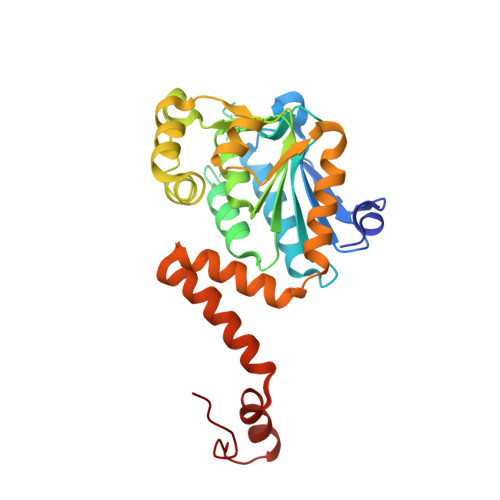Active site binding and catalytic role of bicarbonate in 1,4-dihydroxy-2-naphthoyl coenzyme A synthases from vitamin K biosynthetic pathways
Sun, Y.R., Song, H.G., Li, J., Jiang, M., Li, Y., Zhou, J.H., Guo, Z.H.(2012) Biochemistry 51: 4580-4589
- PubMed: 22606952
- DOI: https://doi.org/10.1021/bi300486j
- Primary Citation of Related Structures:
4ELS, 4ELW, 4ELX, 4EML - PubMed Abstract:
1,4-Dihydroxy-2-naphthoyl coenzyme A (DHNA-CoA) synthase, or MenB, catalyzes a carbon-carbon bond formation reaction in the biosynthesis of both vitamin K1 and K2. Bicarbonate is crucial to the activity of a large subset of its orthologues but lacks a clearly defined structural and mechanistic role. Here we determine the crystal structure of the holoenzymes from Escherichia coli at 2.30 Å and Synechocystis sp. PCC6803 at 2.04 Å, in which the bicarbonate cofactor is bound to the enzyme active site at a position equivalent to that of the side chain carboxylate of an aspartate residue conserved among bicarbonate-insensitive DHNA-CoA synthases. Binding of the planar anion involves both nonspecific electrostatic attraction and specific hydrogen bonding and hydrophobic interactions. In the absence of bicarbonate, the anion binding site is occupied by a chloride ion or nitrate, an inhibitor directly competing with bicarbonate. These results provide a solid structural basis for the bicarbonate dependence of the enzymatic activity of type I DHNA-CoA synthases. The unique location of the bicarbonate ion in relation to the expected position of the substrate α-proton in the enzyme's active site suggests a critical catalytic role for the anionic cofactor as a catalytic base in enolate formation.
- Department of Chemistry and State Key Laboratory of Molecular Neuroscience, The Hong Kong University of Science and Technology, Clear Water Bay, Kowloon, Hong Kong SAR, China.
Organizational Affiliation:





















